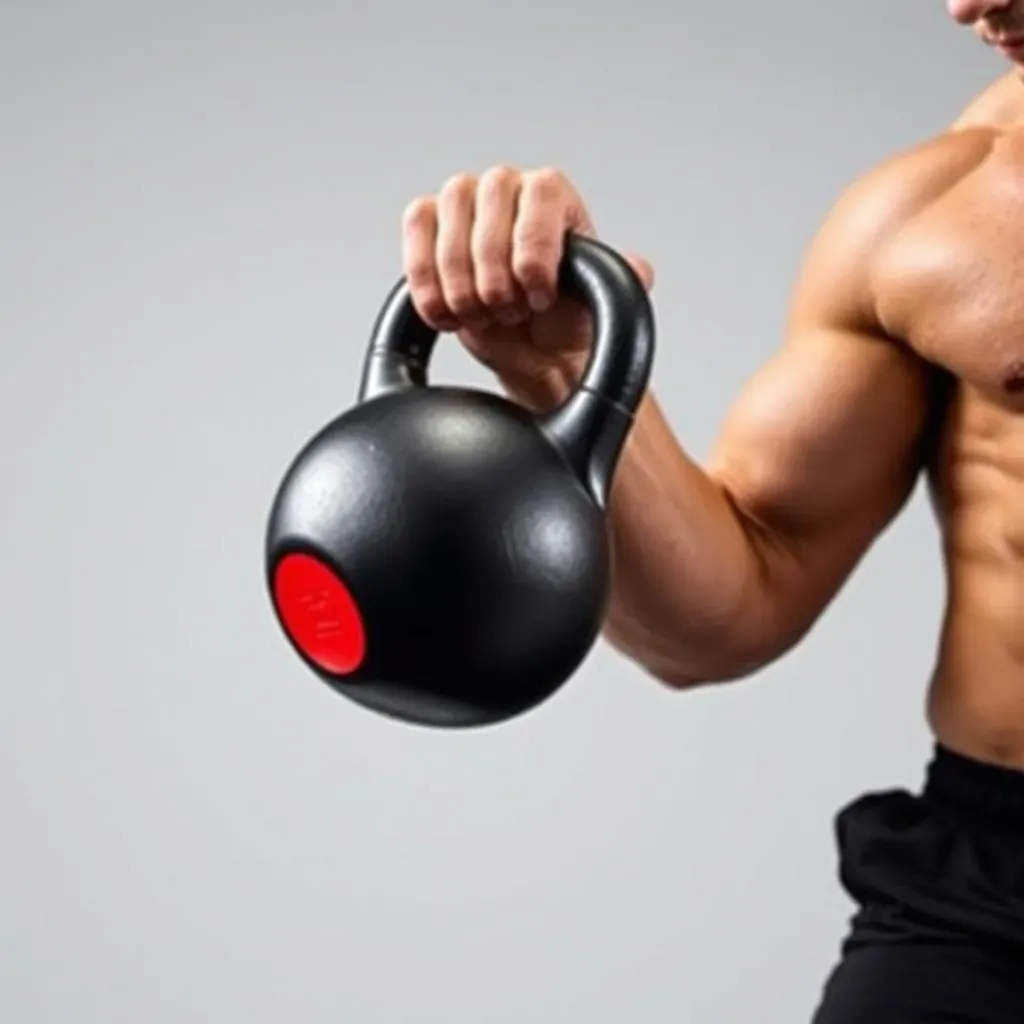Table of Contents
Ready to unlock a world of strength and fitness? This guide is your key to mastering two-handed kettlebell exercises. Whether you're a complete beginner or looking to expand your workout routine, we'll cover everything you need to know. We'll start by helping you choose the right kettlebell weight and emphasizing the importance of proper form to avoid injuries. Then, we'll dive into some fundamental two-handed kettlebell exercises, like the classic kettlebell swing and the surprisingly effective goblet squat, explaining each step with clear instructions and helpful visuals. You'll learn how to incorporate these exercises into effective workouts tailored to your fitness level. Finally, we'll explore more advanced techniques and variations to challenge yourself as you progress. Get ready to build muscle, boost your endurance, and experience the incredible benefits of 2 handed kettlebell exercises. Let's get started!
Getting Started: Choosing Your Kettlebell and Mastering Proper Form

Getting Started: Choosing Your Kettlebell and Mastering Proper Form
Finding Your Perfect Kettlebell
So, you're ready to dive into the world of two-handed kettlebell exercises! Awesome! First things first: picking the right kettlebell. Don't go overboard; start with a weight you can comfortably handle for 10-12 repetitions of basic exercises like swings. Too heavy, and you'll risk injury and bad form; too light, and you won't get a good workout. A good starting point for many beginners is an 8kg (18lb) kettlebell, but this depends on your current fitness level. If you're brand new to exercise, even a 4kg (9lb) might be a better starting point. Need help choosing a weight? Check out this beginner kettlebell program for more guidance.
Remember, it's better to start light and gradually increase the weight as you get stronger. It's all about building a solid foundation and avoiding injury. Don't rush into heavier weights. Think of it like building a house – you wouldn't try to put on the roof before laying the foundation, right? Building strength takes time, so be patient with yourself. Consistency is key! And remember, you can always adjust the weight based on your needs during the exercise.
Your Fitness Level | Recommended Starting Weight (kg) | Recommended Starting Weight (lbs) |
|---|---|---|
Beginner | 4-8 | 9-18 |
Intermediate | 12-16 | 26-35 |
Advanced | 16+ | 35+ |
Mastering the Fundamentals: Proper Form
Proper form is crucial for getting the most out of your workout and avoiding injuries. Think of your body as a finely tuned machine; improper form throws everything out of whack. Before you even think about lifting, take some time to learn the correct technique for each exercise. There are tons of great videos online and resources available (like the one linked below) that demonstrate proper form for common kettlebell exercises. Take it slow, focus on your form, and don't be afraid to start with fewer reps if that helps you maintain good form. You can always increase the repetitions as you get more comfortable and confident.
Imagine trying to build a sandcastle on a wobbly foundation – it’s going to fall apart quickly. Similarly, poor form when lifting weights can lead to injury. Prioritize proper form over speed and number of reps, especially when you’re starting. Watch yourself in a mirror, and film yourself doing the exercises to help you identify areas for improvement. It's also a great idea to consult with a qualified fitness professional if you're unsure about your form. They can provide personalized guidance and help you avoid common mistakes.
- Start with lighter weights to focus on technique.
- Watch videos demonstrating proper form.
- Use a mirror to check your posture.
- Consider consulting a personal trainer.
For more tips on getting started with kettlebells, check out our beginner kettlebell workout guide.
Fundamental TwoHanded Kettlebell Exercises: Swings, Goblet Squats, and More

Fundamental TwoHanded Kettlebell Exercises: Swings, Goblet Squats, and More
The Kettlebell Swing: Your Foundation Exercise
Let's start with the king of two-handed kettlebell exercises: the swing. It's deceptively simple, but incredibly effective for building strength and conditioning your entire body. It's like a full-body dance, engaging your legs, core, and back in a powerful, coordinated movement. The secret? It's all about hip hinge and explosive power from your legs, not just your arms. Think of it as a pendulum – you're using your legs to generate the momentum, and your arms are just along for the ride.
Start with your feet shoulder-width apart, holding the kettlebell between your legs. Hinge at your hips, keeping your back straight, and swing the kettlebell back between your legs. Then, explosively drive through your hips and legs, swinging the kettlebell up to shoulder height. Control the kettlebell on the way down, and repeat. It's important to focus on proper form to maximize effectiveness and prevent injuries. For a more detailed guide, check out this beginner kettlebell program.
Step | Description |
|---|---|
1 | Stand with feet shoulder-width apart, kettlebell between legs. |
2 | Hinge at hips, swing kettlebell back. |
3 | Explosively drive through hips and legs, swing up to shoulder height. |
4 | Controlled descent, repeat. |
Goblet Squats: A Powerful Lower Body Builder
Next up is the goblet squat, a fantastic exercise for building lower body strength and improving mobility. Hold the kettlebell close to your chest, like you're holding a goblet, hence the name. Squat down until your thighs are parallel to the ground, keeping your back straight and chest up. Push through your heels to return to the standing position. It's a simple movement, but it's amazing how challenging it can be, especially when you're first starting out. You'll feel the burn in your quads, glutes, and even your core.
The goblet squat is a great way to build a strong foundation for more advanced exercises. It's also relatively low impact, making it suitable for people with knee problems (always consult your doctor first, of course!). Remember to keep your back straight and your core engaged throughout the movement. Focus on controlling the descent and the ascent, and avoid bouncing at the bottom. A slow and controlled movement is better than a fast and sloppy one. Find a full body workout here: full body kettlebell workout.
- Hold kettlebell close to chest.
- Squat until thighs are parallel to the ground.
- Keep back straight, chest up.
- Push through heels to return to standing.
Building Your Workout: Creating Effective TwoHanded Kettlebell Routines

Building Your Workout: Creating Effective TwoHanded Kettlebell Routines
Building Your First Routine: A Simple, Effective Starting Point
Okay, so you've mastered the basics – fantastic! Now, let's build your first kettlebell workout routine. Remember, consistency is key, so start with a routine you can stick to. Aim for 2-3 workouts per week, with at least one day of rest in between to let your muscles recover. Don't try to do too much too soon; start with a shorter workout (20-30 minutes) and gradually increase the duration and intensity as you get stronger. A good starting point is a full-body routine that incorporates the kettlebell swing, goblet squats, and maybe a few other exercises you feel comfortable with, like rows or presses. Focus on quality over quantity – remember that proper form is crucial. A shorter, well-executed workout is always better than a longer, sloppy one.
For example, you could start with 3 sets of 10-12 repetitions of kettlebell swings, followed by 3 sets of 10-12 goblet squats. Add in some simple bodyweight exercises like push-ups or planks to round out your workout. Listen to your body and adjust the number of sets and repetitions as needed. Remember, you're building a foundation of strength and endurance, not trying to break a record on day one. For more workout ideas, check out our 20-minute kettlebell workout for beginners.
- Choose 2-3 exercises.
- Start with 3 sets of 10-12 reps.
- Gradually increase sets and reps.
- Rest at least one day between workouts.
Progressing Your Routine: Adding Intensity and Variety
Once you've established a solid base, it's time to start adding intensity and variety to your routine. This could involve increasing the weight of your kettlebell, increasing the number of sets and repetitions, or incorporating more challenging exercises. You could also try adding different variations of the exercises you're already doing, or incorporating entirely new exercises into your routine. The key is to keep challenging yourself and keep your workouts interesting. Don't be afraid to experiment and find what works best for you. Remember, the goal is to keep making progress and seeing improvements in your strength and fitness.
Consider adding exercises like kettlebell cleans or snatches (once you've mastered proper form!), or incorporating more advanced variations of squats, like Bulgarian split squats. You can also try incorporating different training styles, such as circuit training or high-intensity interval training (HIIT). Remember to listen to your body and adjust your workout accordingly. You might find that a shorter, more intense workout is more effective than a longer, less intense one, or vice versa. Find the balance that works best for you and your goals. For women over 50, check out our kettlebell workout guide.
Week | Focus | Example Exercises |
|---|---|---|
1-4 | Foundation | Swings, Goblet Squats |
5-8 | Progression | Clean, Snatch, Rows |
9+ | Advanced | HIIT, Circuit Training |
Beyond the Basics: Advanced TwoHanded Kettlebell Techniques and Variations

Beyond the Basics: Advanced TwoHanded Kettlebell Techniques and Variations
Kettlebell Cleans: Power and Precision
Alright, you've conquered the swing and goblet squat. Now it's time to level up with the kettlebell clean! This move is a dynamic exercise that combines explosive power with controlled precision. Think of it as a controlled snatch, emphasizing a powerful hip drive that propels the kettlebell from the ground to your shoulders. It's a full-body exercise that will really challenge your coordination and strength.
The kettlebell clean involves a powerful hip drive and a controlled "catch" at the shoulder level. It's more complex than the swing, so focus on mastering the movement before increasing the weight. Start light, focus on form, and gradually increase the weight as you become more comfortable and confident. Check out this ultimate kettlebell workout for beginners for more guidance.
- Start with a light kettlebell.
- Focus on proper form and technique.
- Gradually increase the weight as you get stronger.
- Practice the movement slowly and deliberately.
Kettlebell Snatches: The Ultimate Full-Body Challenge
Ready for a real challenge? Let's talk kettlebell snatches! This is the ultimate full-body exercise, requiring explosive power, coordination, and precise technique. It’s a complex move that combines elements of the clean and overhead press, propelling the kettlebell from the ground all the way overhead in one fluid motion. It's a seriously impressive move to master, and it will undoubtedly push your limits.
The kettlebell snatch is a powerful full-body exercise that develops explosive power, coordination, and overall strength. It's a more advanced move, so make sure you have a solid foundation in basic kettlebell exercises before attempting it. Start with a very light kettlebell and focus on proper form before increasing the weight. It's also a good idea to work with a qualified trainer to learn the correct technique. For a comprehensive guide on kettlebell exercises, check out this PDF guide.
Step | Description |
|---|---|
1 | Start with feet shoulder-width apart. |
2 | Powerfully swing the kettlebell up, catching it overhead. |
3 | Controlled descent, repeat. |